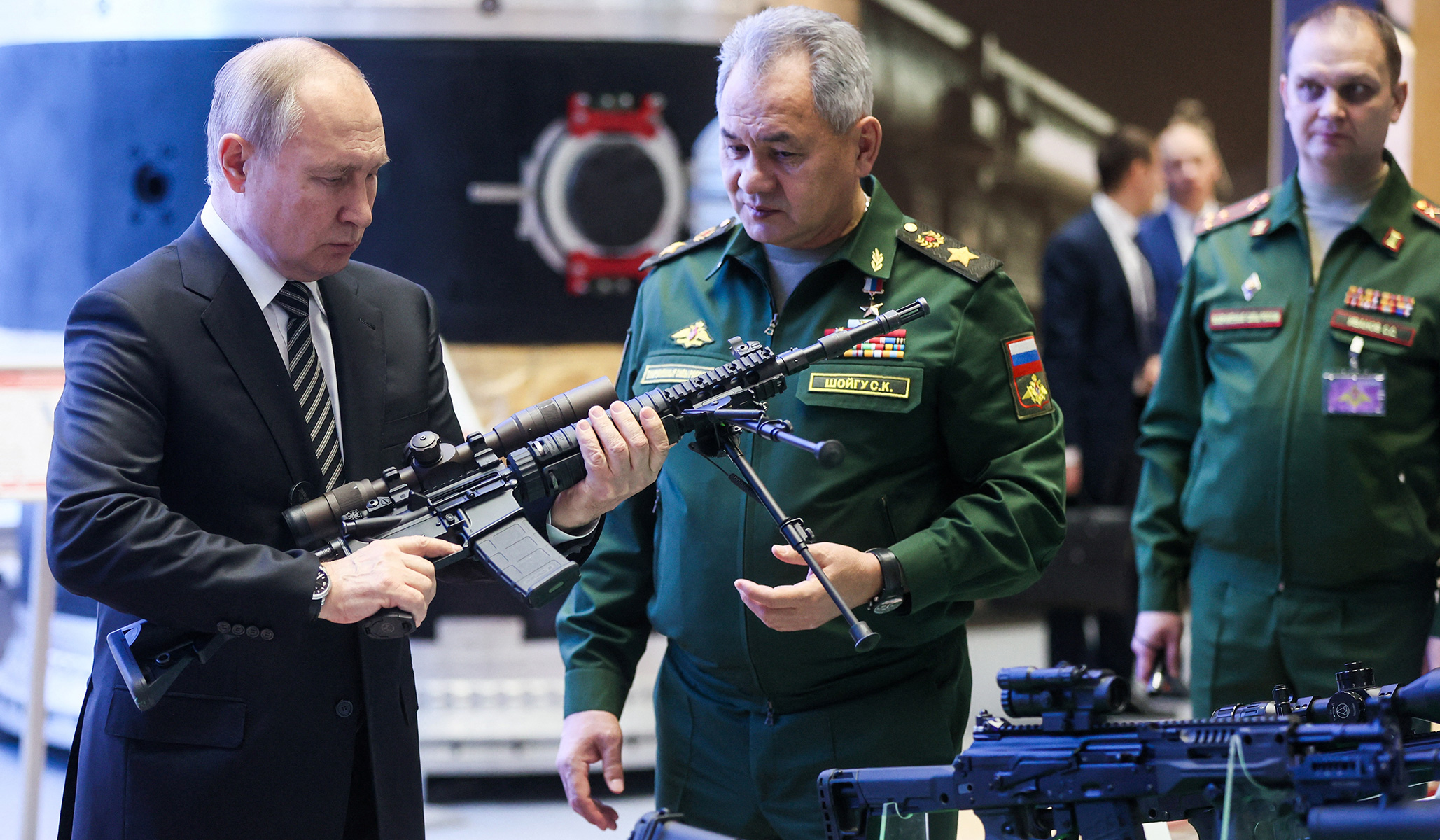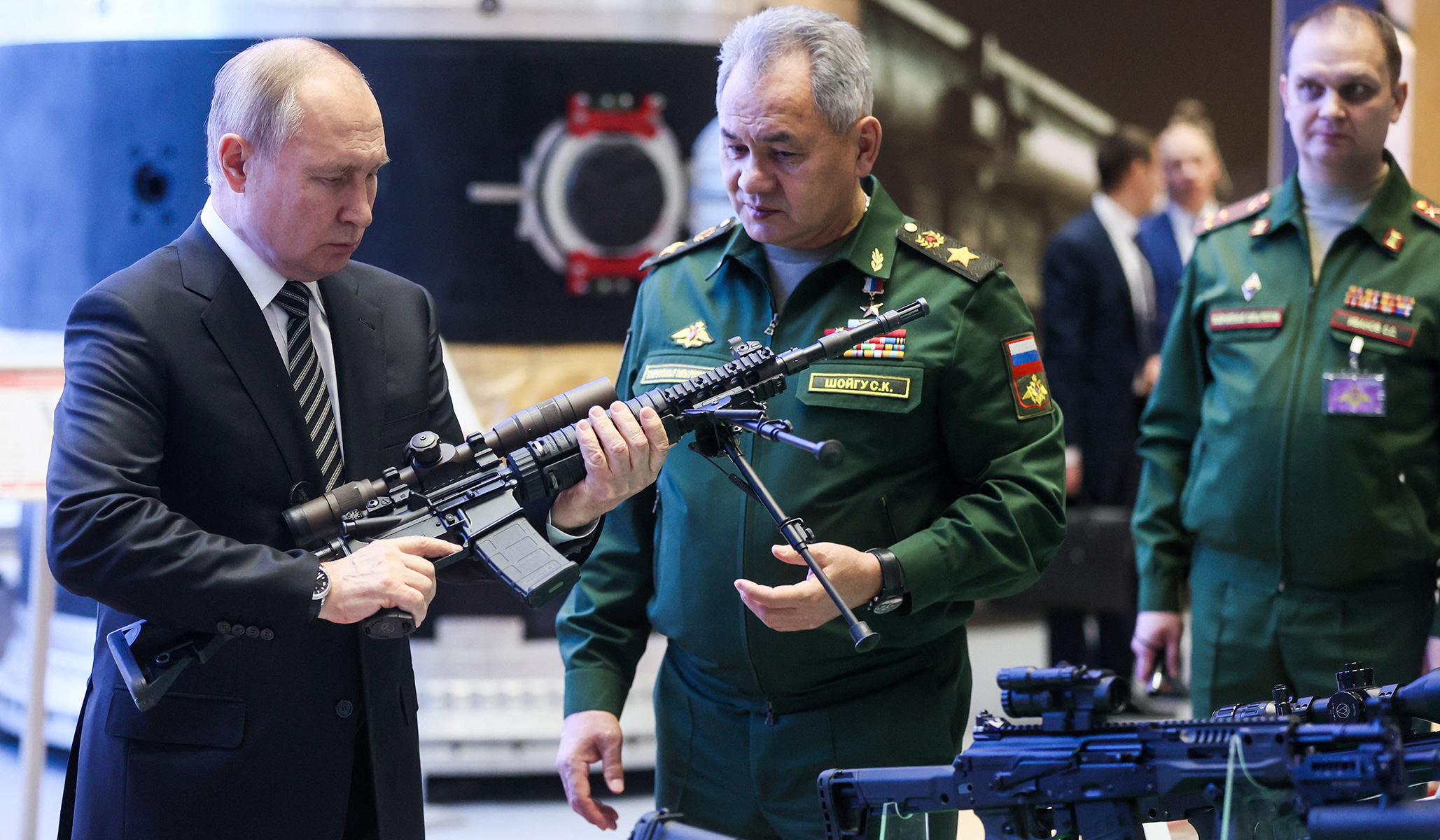
(Mikhail Metzel/Sputnik via Reuters)
On the menu today: two bits of really bad news and then some serious hope. The evidence is piling up that Vladimir Putin really does intend to invade Ukraine later this winter. Meanwhile, at home, President Biden offers utterly lame excuses that no one could have possibly foreseen surging demands for Covid-19 tests this winter. But over at Walter Reed Army Institute of Research, scientists think they’ve developed the variant-killer, the One Vaccine to Defeat Them All.
Is Vladimir Putin Bending His Knees?
I don’t want to serve up a heaping portion of ominous news right before the holidays, but this thread from Dmitri Alperovitch, the Russian-born U.S. computer executive and co-founder of the cybersecurity firm CrowdStrike, lays out a thoroughly unnerving case that Vladimir Putin is going to invade Ukraine later this winter.
Could all of this be a feint?
If you’re lucky enough to meet my father, there’s a roughly 50-50 chance that at some point he will tell you a story from his Navy days about serving on the staff of Admiral Thomas Moorer. There is also a good chance he will tell the story about getting some update about hostile-foreign-troop movements, and Moorer asking my dad if he thought it was really a preparation for an invasion. Dad, being of a much lower rank and not knowing one way or another, hedged his answers. Moorer pointed out that, “They’re not bending their knees. When you go to shoot a basketball, what’s the first thing you do? You bend your knees. These guys aren’t bending their knees” — meaning, setting up supply lines and moving material into place — “so this is another training exercise.” And it turned out, it was.
Russia doesn’t appear to have everything in place that they would want for an invasion, at least according to U.S. intelligence officials speaking to Voice of America:
But U.S. intelligence officials, along with European security officials, who spoke on condition of anonymity, say they do not believe an invasion is imminent. They say some key logistics they would expect to see are not in place yet, including more fuel and ammunition stockpiles. They calculate Russia has anything from 70,000 to 100,000 troops already deployed but expect a combined force of around 175,000 to be amassed ahead of any incursion, if Putin decides to launch an attack on Ukraine.
But with that said, a few days ago, the Atlantic Council’s Digital Forensics Research Lab looked at what could be determined from satellite photos and social media in Russia and it laid out an extensive and ongoing troop mobilization:
The DFRLab has tracked Russian military movements throughout December, and found that units from the Central Military District (CMD) continued to use rail services to move equipment hundreds of kilometers toward locations near the Ukraine border. Most recently, units from the St. Petersburg area were spotted relocating to Kursk, roughly 100 kilometers from the Ukraine border.
A new military camp was discovered at a training area east of Kursk, and the 2nd Motor Rifle Division (MRD) appeared to be active in the region, according to a December 9 report by Janes. Open-source videos show trains with equipment from the 138th and the 25th Motor Rifle Brigades (MRB), from the 6th Army near St. Petersburg, had moved to Otreshkovo station, located five kilometers from this training area.
Movement near the Belarus border has also been identified. In November, Ukrainian intelligence suggested that Russia would move elements from the 2nd MRD into Belarus to pressure Ukraine’s northern flank. Video footage recently shared on social media revealed westward Russian military movement, toward the Belarus border, through the village of Kletnya in Bryansk Oblast. There is, however, no evidence that Russian military equipment has entered Belarusian territory in connection with a potential invasion at this point, and no true indication of what unit the equipment belonged to.
Given the large amount of equipment amassing near the Ukraine border, and the comparatively small size of known camps, the prevailing theory holds that there are several other undiscovered small camps, like the one discovered in Kursk, scattered throughout Kursk and Bryansk Oblasts.
Those knees don’t look all that stiff, do they?
Then there’s the cyberwarfare front. A few days ago, the New York Times reported how Russian hackers are extremely likely to take down the Ukrainian electrical grid in an invasion scenario:
The Ukrainian grid was built in the days of the Soviet Union, connected to Russia’s. It has been upgraded with Russian parts. The software is as familiar to the attackers as to its operators. And while Ukraine has repeatedly vowed to fix its system, Mr. Putin’s hackers, or at least teams loyal to him, have shown time and time again that they know how to bring parts of the country to a halt.
In an interview, Sean Plankey, a former Energy Department cyberexpert who is now an executive at DataRobot, said that Russian hackers understand every linkage in the design — and most likely have insiders who can help them.
There’s also Vladimir Putin’s rhetoric, which could be mere saber-rattling, but also sounds like the sort of things a leader would say if he was preparing his people for war. “What the U.S. is doing in Ukraine is at our doorstep. . . . And they should understand that we have nowhere further to retreat to. Do they think we’ll just watch idly?” Also note the downright unhinged accusations coming from Russia’s defense minister:
Russian Defense Minister Sergei Shoygu claimed Tuesday that U.S. mercenaries were preparing Ukrainian special forces and radical armed groups for “active hostilities” in eastern Ukraine, and had delivered “an unidentified chemical component” to the region “to commit provocations.”
Shoygu did not provide evidence for his allegations, which he read from a prepared statement at a gathering of Russia’s top military commanders with President Vladimir Putin in attendance.
Meanwhile, pro-Russian social-media accounts are spreading false rumors of U.S. military forces moving toward Poland’s border with Belarus. Someone wants the Russian people to believe that the U.S. and NATO are preparing to attack Belarus and Russia.
But there may not be any sudden, formal, full-on invasion one night. The brilliant British sitcom Yes, Prime Minister had a hilarious, and painfully accurate, description of “Salami Tactics” — a Soviet invasion completed small slice by small slice. No one particular Russian action is likely to spur a full response from NATO. Like the frog in the boiling water, the strategy is to gradually increase aggression and incursions, bit by bit, so that the shift from non-war to war happens so gradually, we never quite realize it. And by the time we do realize it, the Russians have a huge head start.
Toward the end of Alperovitch’s thread, he looks at the geopolitical situation. Russia is the world’s third-largest producer of petroleum and its second-largest producer of natural gas. Oil and natural-gas prices are high; Europe is highly dependent upon Russian energy exports, and the Nord Stream 2 pipeline running from Russia to Germany hasn’t even started operating yet. (Surprise, surprise, European wind power didn’t generate as much energy as projected.) Putin has enormous leverage; the West doesn’t seem all that unified, strong, or confident; and he’s thinking about his legacy before age and mortality catch up with him.
Could a unified NATO deter Putin? Sure. Putin has a ton of personal wealth that sanctions regimes haven’t even begun to touch. Cutting off Russian banks from SWIFT — Society for Worldwide Interbank Financial Telecommunication — would effectively cut off Russian banks from the rest of the world and make it nearly impossible to move money into or out of Russia. That would at least temporarily take a wrecking ball to the Russian economy and crash the value of the ruble. And cyberwarfare is a door that swings both ways. We know U.S. Cyber Command can temporarily shut down Russia’s Internet Research Agency — the bot farms — any time it wants. The allegedly pro-Russian Trump administration fired cyberwarfare “warning shots” by disrupted the Russian power grid in 2019. And U.S. arms exports could make trying to take over Ukraine like trying to take over Texas. If you’re comfortable with every citizen armed to the teeth and plotting to ambush your troops every day and every night, go right ahead. It’ll make Afghanistan look like a tea party.
If NATO leaders had the will, they could make life extremely difficult for Vladimir Putin and his closest allies and make the consequences for military aggression hit extremely close to home.
But facing down Putin requires U.S. leadership and the will to publicly demonstrate that this matters to us. Putin is betting that deep down, no one in NATO — either in elected office or in NATO countries’ publics — cares that much about the lands on the east side of the Dnieper River. Russian forces could roll into half the country and then declare they recognize “independent” “East Ukraine.”
What is a man like President Biden willing to do about it?
No, Mr. President, Covid Didn’t Spread Overnight
Speaking of President Biden, yesterday he said:
Q: Is it a failure that you don’t have an adequate amount of tests for everyone to be able to get one if they need one right now?
THE PRESIDENT: No, it’s not, because COVID is spreading so rapidly, if you notice. It just — just happened almost overnight, just in the last month. And —And so, no, it’s not a failure, but the alarm bell went off. I don’t think anybody anticipated that this was going to be as rapidly spreading as it did.
And so, the question is: We had a lot of people who have access to a test, who could order them, could — could have their insurance pay for them, et cetera.
But it all started — all of a sudden, it was like everybody rushed to the counter. There was a big, big rush.
You know that’s not true, because you read yesterday’s Morning Jolt — the CDC and major media institutions have been warning about a shortage of tests for months now. Companies that develop tests have been complaining about the FDA’s glacial and complicated approval process for years now. And anybody who knows anything about upper respiratory viruses would know caseloads increase in winter.
Martha McCallum asks, “How is it we keep getting caught off-guard: Omicron, which started in November, and was scary enough to block travel from South Africa, but not ramp up testing here? ‘No one anticipated this, it came out of nowhere. . . .’ Echoes Afghanistan.”
That’s how it’s been with this president and this administration from the beginning. “No one saw inflation coming.” “No one saw the supply-chain crisis coming.” “No one saw the labor shortage coming.” “No one saw the surge of migrants at the border coming.” This administration has spent a huge chunk of the past year futzing around with pipe dreams of being FDR or LBJ and passing Build Back Better, while real problems such as inflation, the supply chain, labor shortages, crime, and the border worsened.
ADDENDUM: Hoorah, U.S. Army!
Within weeks, scientists at the Walter Reed Army Institute of Research expect to announce that they have developed a vaccine that is effective against COVID-19 and all its variants, even Omicron, as well as from previous SARS-origin viruses that have killed millions of people worldwide.
The achievement is the result of almost two years of work on the virus. The Army lab received its first DNA sequencing of the COVID-19 virus in early 2020. Very early on, Walter Reed’s infectious diseases branch decided to focus on making a vaccine that would work against not just the existing strain but all of its potential variants as well.
Walter Reed is calling it the “Spike Ferritin Nanoparticle (SpFN) COVID-19 vaccine” but it needs a much cooler name. I recommend “Covidbane: The One Vaccine to Rule Them All.”

